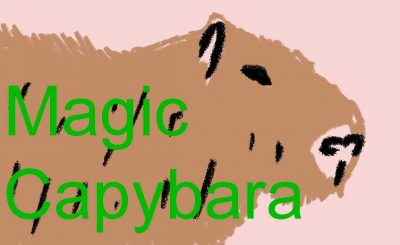One of the most important assets for any game is the key art – promotional visual imagery that is used to communicate the game’s themes, genres and identity to potential players. Key art can be found on nearly every platform, from social media headers to physical game copies, store pages to posters on double-decker buses. Impactful key art is a powerful tool in marketing – it can help you stand out in a crowded market and can often be the very first thing that players see in relation to your project. The quality, suitability and appeal of what they see can easily be the difference between them finding out more, and skipping your game altogether.
For many indie games, key art is often limited to the digital space – as physical publishing and traditional advertising are expensive marketing channels for the humble first game. This often includes social media channels, email marketing ads and arguably most importantly – the store page. Whether you’re launching on Steam, Epic or Nintendo eStore, your game will need to have key art as one of its main marketing materials. When used on these store pages, the key art is often referred to as a capsule or capsule art. These are the images you see when browsing an online store, and on a game’s store page – the visual identity of your brand and project.
To help your game succeed, your capsules should be impactful and marketable. There are hundreds of games releasing daily across all gaming platforms in every genre, from huge triple AAAs to tiny indies, from sprawling MMOs to 2-hour narrative adventures. These are all vying for attention and will be your competition. Not only does your capsule art need to stand out, but it must also successfully communicate the game’s appeal and theme to let players know whether this is something they would be interested in.
So how do you design your capsule art to be marketable?

Follow the Rules
First and foremost, you need to know which store pages you are planning to use – each one has particular rules for capsule art on their platform, and you will need to ensure that you note down the right dimensions and guidelines before getting started.
For example, Steam requires your game to have a header capsule (sized at 460px x 215px), a small capsule (sized at 231px x 87px), a main capsule (sized at 616px x 353px) and a hero capsule (sized at 374px x 448px). Each of these capsules serves a different purpose – for example the small capsule will be shown when your game appears in search or in “Other Games Like This”, while the header capsule appears in the top right of your game’s store page. As such, they must be designed differently, but still keep your brand and identity consistent, through the use of color schemes, motifs, fonts and of course, your logo.

Quality and Clarity
Next, after considering the dimensions and guidelines of your store page, you must ensure that you design your capsule art to be both high-quality and very clear. Players are less likely to take your game seriously if the capsule they see is blurry, unreadable or looks like it was created in 2 minutes in Microsoft Paint (unless that is the look you decided to go for as part of your marketing strategy!)
Make sure that the game’s name and logo are easily visible in all formats. This is especially key for smaller capsules like those that appear in search, as these are often very small. Steam’s official guidelines echo this, indicating a requirement for the small capsule as:
“Small Capsule should contain readable logo, even at smallest size. In most cases, this means your logo should nearly fill the small capsule.”
When you look at current games, you can see how other studios have taken heed of this advice to create clear capsule art, and often those who have not. While AAAs often have a wealth of brand recognition they can rely on, for an indie game is it especially key to look as polished and clear as possible to help your game stand out and be visually appealing.

Be Unique
As well as being clear and high-quality, your capsules should be visually appealing and communicate your game’s unique selling points to hopefully convince players to find out more and ultimately buy your game. This is a little less clear-cut as each game is unique and will (in most cases) have its own identity.
The first thing you can ask yourself is – is there already key art for the game that could be repurposed for your capsules? It’s always a good idea to maintain consistency across your many platforms and it can help with brand recognition and helps position your game as high-quality and professional. However, be careful with this approach as not all key art will be suitable for a capsule, especially if it has been designed to appear in larger formats like on a website. Having a highly detailed capsule with lots going on can make it difficult to make out what is being depicted or what the game is about.
If you don’t already have suitable key art – you will need to create some. Think about your game and everything that it offers players. What are its genres? What is the plot? What themes and feelings do you want to convey? What are the main features? Once you have a general picture of what the game looks and feels like, you will need to think about its unique selling points. What helps it stand out from the competition? Is it a cool mechanic that hasn’t been tried before? Is it a cast of lovable and complex characters? Is it a sandbox game where you can literally do anything? All of these USPs can be represented visually in different ways. Going through this process will help you understand what you want your capsule to focus on, and you want players to feel when they see it.
Competition &Trends
Once you have answered these questions and have thought about what you want your capsule art to contain, a good natural step is to do some research. This involves going to the storefront of your choice and seeing what other games in your genre are doing with their key art, how games similar to yours have communicated their games visually and what the current trends are.
Genre research can be really helpful in showing you what players of any particular genre are expecting from a new game. Often, genres have very specific ways in which they use capsule art to communicate themes and features, which together combine to become staples of a genre. One clear example of this is FMV (full motion video) games – “a video game narration technique that relies upon pre-recorded video files (rather than sprites, vectors, or 3D models) to display action in the game” (Wikipedia). Here are some example header capsules from Steam of games in the FMV genre:
From these examples we can see games in the FMV genre often (but not always) utilise photographs of the actors in the game to communicate the genre – showing that the game contains real people rather than rendered characters. Additionally, we get the sense that FMVs generally deal with serious subjects – as can be seen through the choice of shots, colour schemes and expressions used in the capsule. Doing this research can help you understand how your game can fit in with players’ expectations of a genre, or alternatively help you stand out from the competition if your game goes against genre conventions (for example a really up-beat silly FMV).
Competitor research can be used in a similar way, though this is usually more targeted than genre research. Here you need to think about which games are similar to yours in more than just genre. By finding these comparable games and seeing how they have communicated through their key art and capsules you can consider how you can help your game stand out.
For example, let’s take the recent launch of Valheim, an open-world survival game with a Viking theme. Here is the capsule art:

Notice how the capsule conveys two of Valheim’s core USPs on the market – the unique viking setting (the shield) and the co-operative play (showing two characters). This helps it stand out, as in contrast, other capsule art of games in a similar genre and with similar mechanics, often portrays solitary characters or create a sense of isolation.
The last thing to look out for is capsule art trends. Often, as different games experiment with new key art and find things that work, you will see particular trends becoming more popular, whether it’s a particular colour scheme, art style or even logo position. Research what is trending right now on the store front of your choice to understand what is working for others and what players expect.
A good place to start is Chris Zukowski’s website How To Market a Game and his well-researched and insightful articles on capsule trends in July 2020 and October 2020.
Final note
Ensuring that you have thought strategically about your capsule art will help the marketability and overall success of your indie game. Remember:
- Check the capsule art rules and guidelines for your platform.
- Make sure your capsure art is high-quality and clear.
- Help your game stand out by focusing on its selling points and how you want players to feel.
- Carry out research to check what is expected in your genre.
Armed with this knowledge, you should be able to more confidently design capsule art which will help you market your game. Happy creating!





